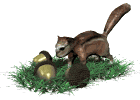
In our journey through the fascinating discipline of biology, we will frequently encounter the "lumpers" and the "splitters". The "lumpers" are in favor of larger, more inclusive groupings and the "splitters" in favor of a greater number of more narrowly defined categories. You will likely be happy to hear that I tend to favor the "lumpers" over the "splitters".
On a smaller scale, mountains and other geographical features affect temperature and moisture and therefore the types of plants and animals that occur in an area.
This is an animated picture of the same concept.
The windward side of a mountain receives more rain due to the moisture loss from ascending air that cools as it rises. As the dry air descends on the other side of the mountain, it warms again and absorbs water resulting in deserts on what is called the rain shadow side of the mountain.
This animation (Audio - Important) illustrates the rain shadow effect.
Now let's go to the NASA website to expand our understanding of biomes. Take a look at each of the 7 biomes described to get a feel for the variation in temperature, moisture and their characteristic plants. You do not need to follow the links at the bottom of each biome description (unless you want to). Then take the plant quiz and try your hand at the Great Graph Match.
And, that's it for today. We've crystallized whatever fuzzy notions we might have about the characteristics of a living organism and how they would differ from coffee mugs and rocks. Also, you should have a pretty clear picture of why certain plants and animals live where they do.
The NASA web site gave you a good idea about the types of plants characteristic of different biomes. The Enchanted Learning website can give you some good ideas on the types of animals characteristic of the various biomes.
Try to figure out which biome you grew up in, or may have vacationed in. If your not certain, perusing either this US or world map should help you figure it out.
This animated map also illustrates biomes.
The National Geographic web site describes 867 ecoregions and has lots of examples of endangered plants and animals in those regions. Definitely the mark of a splitter at work.
Next lecture we will talk about what water is and why it plays such an important role in determining the habitats of plants and animals throughout the world.
REVIEW: The Creosote Bush is typical of which biome�
REVIEW: In which biome would you expect to find Spruce�
REVIEW: Flowering Dogwood is most likely to be found in�
REVIEW: Orchids are characteristic of which biome�
REVIEW: Lichens are typical of which biome�
REVIEW: Bluestem Grasses are most likely to be found in�
REVIEW: White Sage is commonly found in which biome�
REVIEW: Saguaro Cactus would most likely be found in which biome�
PREVIOUS